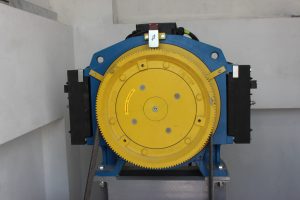
An Elevator Traction Gearless Motor is a critical component used in modern elevator systems, particularly in high-rise buildings or those that require faster, smoother, and more energy-efficient operation. As the name suggests, it operates without the traditional gear system found in older traction motors. Instead, it directly drives the elevator’s sheave (the pulley that moves the elevator cables) without intermediate gears, offering several benefits over geared systems.
Key Features & Functions:
- Direct Drive Mechanism:
- A gearless motor directly drives the traction sheave (the wheel that moves the elevator cables), eliminating the need for reduction gears. This design allows the motor to rotate at a higher speed, and the sheave’s rotational speed is adjusted using the size of the sheave rather than through gear ratios.
- Efficient Power Transmission:
- Since there are no gears involved, the power from the motor is transmitted more efficiently to the sheave. This direct drive mechanism results in lower energy loss, making it more energy-efficient compared to gear-driven systems.
- Smooth and Quiet Operation:
- The absence of gears reduces mechanical friction and noise, which translates to a smoother and quieter ride for passengers. This is especially advantageous in buildings where noise levels need to be kept to a minimum, such as residential buildings or hotels.
- Compact Design:
- Gearless motors tend to be more compact and require less space than traditional geared motors. The motor is typically mounted at the top of the elevator shaft, making it ideal for applications with limited space.
- High Efficiency and Performance:
- Gearless motors are highly efficient because they don’t have the energy losses typically associated with gears. As a result, they provide faster acceleration, deceleration, and more precise control of the elevator’s movements.
- Reduced Maintenance Needs:
- With no gears to wear out or oil to maintain, gearless motors generally require less maintenance than their geared counterparts. This reduces the risk of mechanical failures and lowers long-term operating costs.
- Regenerative Braking:
- Many gearless motor systems are designed with regenerative braking capabilities, which means that when the elevator is descending, the motor can act as a generator to convert the kinetic energy into electrical energy, which is then fed back into the building’s power grid. This feature makes gearless motors highly energy-efficient and environmentally friendly.
- High-Speed Capability:
- Gearless traction motors are particularly suited for high-speed elevator applications. Since there are no gears to slow down the system, they can achieve higher speeds, making them ideal for tall buildings and skyscrapers.
- Precision Control:
- These motors are paired with advanced control systems, enabling precise stopping, smooth acceleration, and deceleration. This results in a more comfortable and stable ride for passengers.
Components of a Gearless Traction Motor:
- Motor: The main component, often an induction motor or a permanent magnet motor, provides the rotational power to drive the sheave.
- Sheave (Pulley): The large wheel that moves the elevator cables. In a gearless system, the motor is connected directly to this sheave.
- Hoisting Ropes/Cables: These cables loop over the sheave and are responsible for moving the elevator car up and down.
- Brake System: The motor includes an electromagnetic brake that holds the elevator in place when it’s stationary and applies braking force when required.
- Controller and Inverter: These electronic components manage the motor’s speed and ensure smooth, controlled operation, as well as provide regenerative braking features.
Advantages of Elevator Gearless Traction Motors:
- Energy Efficiency: Direct power transmission results in lower energy consumption, making it more cost-effective over time.
- Quietness: With no gears, the system operates much quieter than traditional geared elevators.
- Smoothness: Offers smoother and more precise control over acceleration, deceleration, and stopping.
- High-Speed Capability: Ideal for high-rise buildings where high-speed operation is required.
- Compact and Space-Saving: The lack of a large gearbox means the system can be more compact, freeing up space for other uses.
- Low Maintenance: Fewer moving parts means less wear and tear, reducing maintenance costs.
Applications:
- High-Rise Buildings: Due to the ability to move quickly and efficiently, gearless motors are commonly used in skyscrapers and buildings with many floors.
- Modern Elevators: They are a common choice for modern elevator designs due to their efficiency and advanced features.
- Energy-Efficient Buildings: With regenerative braking and energy-saving benefits, they are ideal for eco-conscious, energy-efficient projects.
Conclusion:
The Elevator Traction Gearless Motor is a highly advanced and efficient system that offers a range of benefits over traditional geared systems. Its quiet operation, energy efficiency, high-speed performance, and low maintenance requirements make it the preferred choice for modern elevator installations, especially in high-rise buildings or settings where space and noise concerns are important.
Let me know if you’d like more specific details on a particular model or manufacturer’s design!
